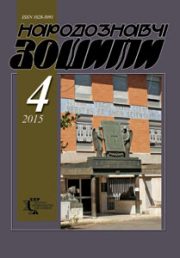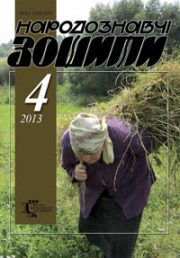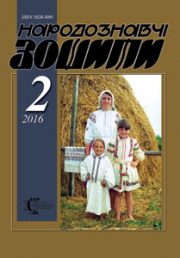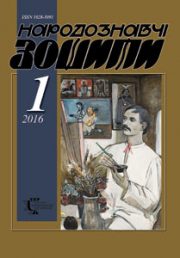The Ethnology Notebooks. 2021. # 2 (158), P. 278—286
УДК 392.1 (477.86)
DOI https://doi.org/10.15407/nz2021.02.278
Lesya HOROSHKO-POHORETSKA
- ORCID ID: https://orcid.org/0000-0002-8741-2467
- Candidate of Historical Sciences (= Ph. D. in history),
- Senior Researcher at the Ethnology,
- Institute of National Academy of Sciences of Ukraine,
- 15, Svobody Avenue, 79000, Lviv, Ukraine,
- e-mail: horoshyna@gmail.com
CHRISTENING OF A BABY IN THE TRADITIONAL PLOT OF POKUTTIA
The purpose of the article is in the coverage of the layer of custom-ritual and world-view phenomena associated with the birth of the child. Theobject of the research is the traditional outlook and the custom and rite culture of the inhabitants of Pokuttia, and the subject — christening of an infant in Pokuttia. In particular, the article examines a number of ritual realities that accompany the church rite of baptism of a child — a holy sacrament designed to cleanse the child from original sin and incorporate him to the Christian faith and community. Among the customs that preceded the church baptism of an infant, it is worth mentioning the «half cross» («pivkhrest») of a weak child, and its symbolic «sale» («prodazh») to strangers, the choice of godparents, the child’s name, especially born out of wedlock, the behavior of godparents: to place a child on a bench in the house, to cross on the threshold of various objects for the purpose of programming to the child of certain qualities in the future, etc. Among the rites that took place after church baptism, the gifting of a child, a midwife, a godparents, the washing of a child, etc. are considered. Beliefs and signs accompanying the church sacrament (observation of the child’s behavior, burning of candles, placing the child under the bench in the church) are not left out either.
The basis for the research are the materials of the author’s field research during 2013—2014 in 40 villages and 3 towns of Kolomyjs’kyj, Gorodenkivs’kyj, Sniatyns’kyj, Tlumats’kyj and Tysmenyts’kyj districts of Ivano-Frankivs’k oblast’, and works of the end of nineteenth and twentieth centuries.
The methodology of this work is based on general scientific methodological principles and the basic requirements that apply to the works of historical-ethnographic direction.
It was found out that the ethnolocal version of the maternity customs of Pokuttia has specific Ukrainian features. At the same time it conserves the distinctive manifestation.
Keywords: christening, christening-party («khrestyny»), child, naming of a baby, Pokuttia.
REFERENCES
- Horoshko-Pohoretska, L. (2017). The prenatal rites of the dwellers of Pokuttia: signs, instructions, warnings. The Ethnology notebooks, 1 (133), 123—128 [in Ukrainian].
- Horoshko-Pohoretska, L. (2019). In order to give birth to a child («Aby zijtysia z dytyny») (maternal cycle of maternity rituals of the inhabitans of Pokuttia). The Ethnology notebooks, 2 (146), 346—353 [in Ukrainian].
- Kolberg, O. (Ed.). (1961). Pokucie. In Kolberg, О. All works (Vol. 29, p. 1). Wroclaw; Poznan: Polskie Wydawnictwo Muzyczne, Ludowa Spуldzielnia Wydawnicza [in Polish].
- Kolberg, O. (Ed.). (1963). Pokucie. In Kolberg, О. All works (Vol. 31, p. 3). Wroclaw; Poznan: Polskie Wydawnictwo Muzyczne, Ludowa Spуldzielnia Wydawnicza [in Polish].
- Mroczko, K.Fr. (1897). Sniatynszczyzna. (A contribution to national ethnography). Scientific and literary guide (Vol. XXV, c. IV, pp. 289—304; c. V, pp. 385—402; c. VI, pp. 481—498; c. VII, pp. 577—595) [in Polish].
- Piotrowicz, S. (1907). The quack and a fortune-teller Jewdokia Bojczuk. Folklore materials from the village Bortnik on Pokucie. People (Vol. XIII, c. II, pp. 118—129; c. III, pp. 216—232 [in Polish].
- Pankiv, M.I. (1988). Family and family life on Pokutye (1850—1980). (Candidate dissertation). Archive of the IN NANU (Archive of the Institute of Ethnology of the National Academy of Sciences of Ukraine). F. 1. Op. 2. Od. save 355 b. Arc. 1—188 [in Ukrainian].
- Gvozdevych, S. (1998). Some aspects of prenatal customs and ordinances of Ukrainian Carpathians. The Ethnology notebooks, 3, 278—280 [in Ukrainian].
- Gvozdevych, S. (1997). The maternity ceremony of Ukrainians. The Ethnology notebooks, 2, 111—122 [in Ukrainian].
- Voznyak, V. (2003). My village — Ukraine’s blossom. Ivano-Frankivsk: Nova Zoria [in Ukrainian].
- Petruk, M., & Petruk, P. (Eds.). (2000). History of Tovmachyk: historical and local essay. Kolomyja: Vil’nyj holos [in Ukrainian].
- Horoshko, L.M. (2013). Field materials from Pokuttia (Kolomyjs’kyj, Gorodenkivs’kyj, Tlumats’kyj, Snyatins’kyj districts, Ivano-Frankivs’k oblast’). Archive of the IN NANU. F. 1. Op. 2. Od. save 698. Arc. 1—116 [in Ukrainian].
- Serebryakova, O.G. (2013). Pokuttia (field materials collected in Kolomyjs’kyj and Snyatins’kyj districts of Ivano-Frankivs’k oblast’). Archive of the IN NANU. F. 1. Op. 2. Od. save 704. Arc. 1—51 [in Ukrainian].
- Horoshko-Pohoretska, L.M. (2014). Field materials from Pokuttia (Tlumats’kyj, Tysmenyts’kyj, Horodenkivs’kyj r-ny, Ivano-Frankivs’k oblast’). Archive of the IN NANU. F. 1. Op. 2. Od. save 736. Arc. 1—97 [in Ukrainian].
- Serebryakova, O.G. (2014). Pokuttia (field materials collected in Tlumats’kyj, Tysmenits’kyj and Gorodenkivs’kyj districts of Ivano-Frankivs’k oblast’). Archive of the IN NANU. F. 1. Op. 2. Od. save 771. Arc. 1—175 [in Ukrainian].
- Serebryakova, O.G. (2016). Pokuttia (field materials collected in Gorodenkivs’kyj districts of Ivano-Frankivs’k oblast’). Archive of the IN NANU. F. 1. Op. 2. Od. save 782. Arc. 1—164 [in Ukrainian].
- Kolberg, O. (Ed.). (1883). Pokucie (Vol. II). Krakуw: W drukarni Uniwersytetu Jagiellonskiego [in Polish].
- Zhybak, G., & Himej, R. (Eds.). (2010). Traditional Ukrainian rites and customs (weddings, christening-party («khrestyny»), «hajivky»). Ivano-Frankivsk: Misto NV [in Ukrainian].
- Horoshko, L.M. (2004). Calendar and family customs and rites in the villages of Drohobyts’kyj and Skolivs’kyj districts of Lviv oblast’, Kosivs’kyj district of Ivano-Frankivs’k oblast’ and Putyl’s’kyj district of Chernivtsi oblast’ (field materials). Archive of the IN NANU. F. 1. Op. 2. Od. save 521. Arc. 1–46 [in Ukrainian].
- Waigiel, L. (1877). A sketch of the city of Kolomyja. Kolomyja [in Polish].
- Borysenko, V. (1994). Maternity customs and rites. In Podillia: historical and ethnographic research (Pp. 211—217). Kyiv: Dolia [in Ukrainian].
- Boriak, O.O. (2009). The Midwife in cultural and historical tradition of Ukrainians: between ordinary and sacred. Kyiv: Institute of Art Studies, Folklore Studies and Ethnology of M. Ryl’skyj of the National Academy of Sciences of Ukraine [in Ukrainian].
- Gavryliuk, N. (2000). Birth of a child. In Ukrainian family: family and social life (Pp. 69—83). Kyiv [in Ukrainian].
- Gavryliuk, N.K. (1981). Mapping of the phenomena of spiritual culture (According to the materials of the birthing rituals of Ukrainians). Kyiv: Naukova dumka [in Russian].
- Gvozdevych, S. (2004). Local features of maternity rituals of Ukrainians in Transcarpathia. Scientific herald of Uzhgorod University. Series history (Issue 10, pp. 173—194) [in Ukrainian].
- Gvozdevych, S. (1997). Maternity rites of Polishchuks. In Polissia of Ukraine: materials of historical and ethnographic research (Issue 1. Kyivs’ke Polissia. 1994, pp. 164—171). L’viv: IN NANU [in Ukrainian].
- Gvozdevych, S. (2002). Maternity customs and ordinances. In Lemkivshchyna: historical and ethnographic research (Vol. 2: Spiritual culture, pp. 64—74). Lviv: IN NANU [in Ukrainian].
- Guzii, R., & Horoshko, L. (2010). Maternity customs and ordinances in Starosambirschyna (on the basis of field research materials). The Ethnology notebooks, 5—6, 611—617 [in Ukrainian].
- Zdoroveha, N. (1983). National customs and rites. In Boykivschyna: historical and ethnographic research (Pp. 232—248). Kyiv: Naukova dumka [in Ukrainian].
- Siavavko, E. (1987). Family Rites. In Hutsul’shchyna: historical and ethnographic research(Pp. 302—319). Kyiv: Naukova dumka [in Ukrainian].
- Kabakova, G., & Tolstoj, N.I. (Ed.). (1995). Breast. In Tolstoj, N.I. Slavic antiquities: ethnolinguistic dictionary: in 5 vol. (Vol. 1: A—G, pp. 563—566). Moscow: Mezhdunarodnyje otnoshenija [in Russian].
- Kabakova, G., & Tolstoj, N.I. (Ed.). (1999). Сhristening-party. In Tolstoj, N.I. Slavic antiquities: ethnolinguistic dictionary: in 5 vol. (Vol. 2: D—K (Crumbs), pp. 658—660). Moscow: Mezhdunarodnyje otnoshenija [in Russian].
- Kabakova, G., & Tolstoj, N.I. (Ed.). (1999). Godparents. In Tolstoj, N.I. Slavic antiquities: ethnolinguistic dictionary: in 5 vol. (Vol. 2: D—K (Crumbs), pp. 660—663). Moscow: Mezhdunarodnyje otnoshenija [in Russian].
- Kabakova, G., & Tolstoj, N.I. (Ed.). (1999). Baptism. In Tolstoj, N.I. Slavic antiquities: ethnolinguistic dictionary: in 5 vol. (Vol. 2: D—K (Crumbs), pp. 664—667). Moscow: Mezhdunarodnyje otnoshenija [in Russian].
- Kabakova, G., & Tolstoj, N.I. (Ed.). (2009). Celebration of birth of child. In Tolstoj, N.I. Slavic antiquities: ethnolinguistic dictionary: in 5 vol. (Vol. 4: P (Crossing the water) — S (Sieve), pp. 446—448). Moscow: Mezhdunarodnyje otnoshenija [in Russian].
- Creative workshop of Iryna Ignatenko. Retrieved from: http://ethnology.com.ua/shop/ (Last accessed: 7/11/2014).







